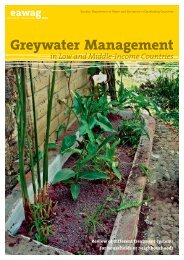Household Water Treatment and Safe Storage Factsheet: Source ...
Household Water Treatment and Safe Storage Factsheet: Source ...
Household Water Treatment and Safe Storage Factsheet: Source ...
Create successful ePaper yourself
Turn your PDF publications into a flip-book with our unique Google optimized e-Paper software.
<strong>Household</strong> <strong>Water</strong> <strong>Treatment</strong> <strong>and</strong> <strong>Safe</strong> <strong>Storage</strong><br />
Fact Sheet: <strong>Source</strong> Protection<br />
Maintain <strong>and</strong> repair all constructed<br />
elements <strong>and</strong> ensure water source <strong>and</strong><br />
structures are physically sealed from<br />
contaminant inflow (e.g. surface run-off)<br />
Ensure watershed use is non-polluting<br />
Maintain separation distances between<br />
source/collection points <strong>and</strong> latrines, washing <strong>and</strong><br />
animal watering points<br />
Wells, Tubewells <strong>and</strong> Boreholes:<br />
Line wells <strong>and</strong> boreholes (provide a<br />
sanitary seal in the top 2 to 3 meters)<br />
Keep protected <strong>and</strong> covered, <strong>and</strong><br />
construct a parapet wall around open wells<br />
Use a separately designated, clean rope<br />
<strong>and</strong> bucket, a windlass or a h<strong>and</strong> pump to<br />
pull water out of the well. Store the bucket<br />
in its own covered clean platform.<br />
Build a platform with adequate drainage at<br />
the collection point to prevent mud <strong>and</strong><br />
wastewater from pooling<br />
Springs <strong>and</strong> Gravity Fed Piped Systems:<br />
Stabilize springs by building retaining walls<br />
<strong>and</strong> collector boxes with screened intakes<br />
Dig a surface water diversion channel,<br />
ditch or bund above <strong>and</strong> around the spring<br />
development<br />
Seal the top of the source with a sanitary<br />
cap when possible to prevent infiltration of<br />
surface run-off<br />
Plant vegetation around the catchment<br />
area but ensure roots will not crack the any<br />
structures<br />
Fence off the spring <strong>and</strong> the catchment<br />
area directly above it to prevent<br />
contamination from livestock or people<br />
For gravity fed systems, protect <strong>and</strong><br />
maintain collection <strong>and</strong> storage tanks, lay<br />
piping 50cm below ground or deeper were<br />
possible<br />
Rivers <strong>and</strong> Lakes:<br />
Mark separate zones for washing <strong>and</strong><br />
watering animals downstream <strong>and</strong> away<br />
from water collection areas<br />
Rainwater Harvesting:<br />
Cut back any trees or vegetation<br />
overhanging the catchment surface<br />
Collect <strong>and</strong> store rainwater in covered<br />
tanks which are periodically cleaned<br />
Clean catchment surface, gutters <strong>and</strong><br />
screens prior to first rain of the season<br />
Divert <strong>and</strong> do not consume water from the<br />
first rain<br />
Use a first-flush system to divert first few<br />
millimetres of each rainfall event as it<br />
contains dust accumulated on the roof or<br />
catchment area<br />
<strong>Water</strong> Collection <strong>and</strong> Transport<br />
It is vital that people collect water in clean<br />
containers <strong>and</strong> keep them covered while<br />
transporting water from the source to the<br />
point of use, to prevent contamination of the<br />
water after collection.
















